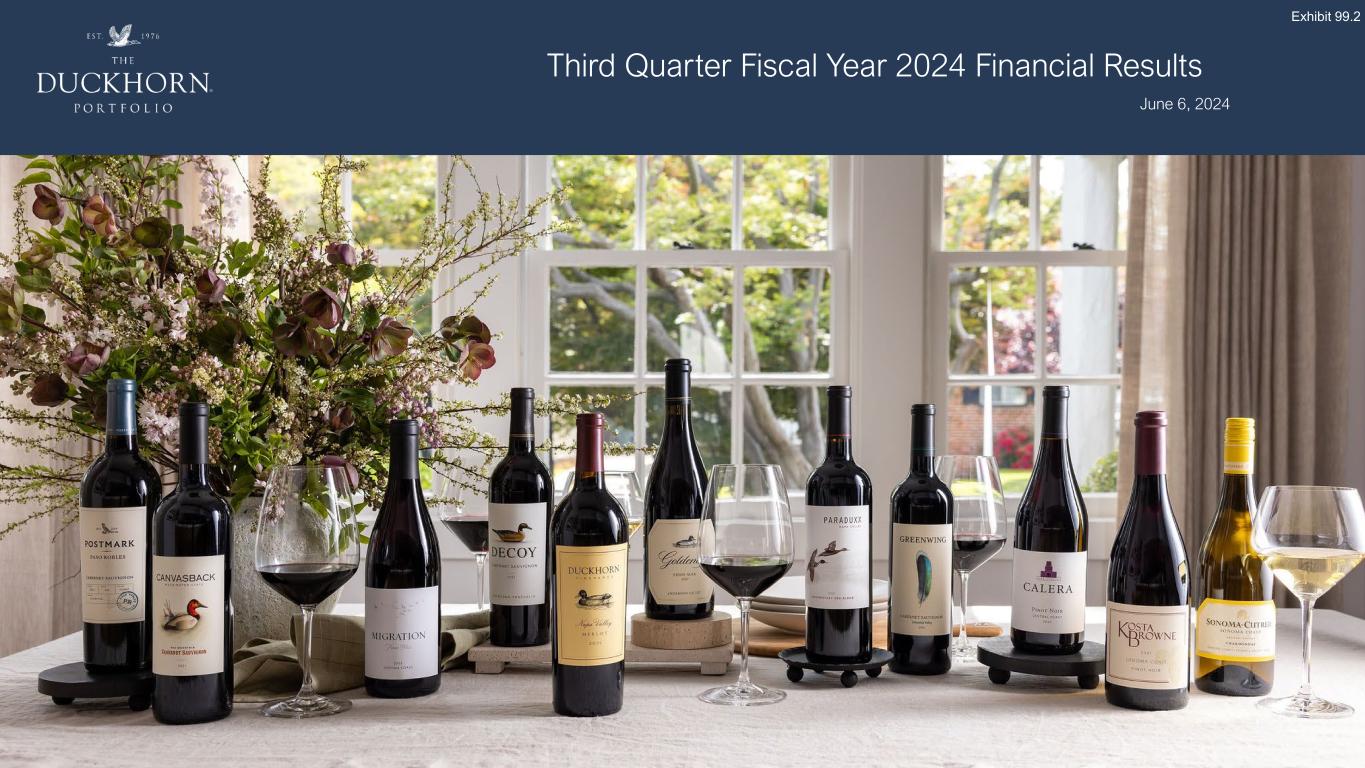
S T R I C T L Y C O N F I D E N T I A L . N O U N A U T H O R I Z E D D I S T R I B U T I O N O R D U P L I C A T I O N . Third Quarter Fiscal Year 2024 Financial Results June 6, 2024 Exhibit 99.2
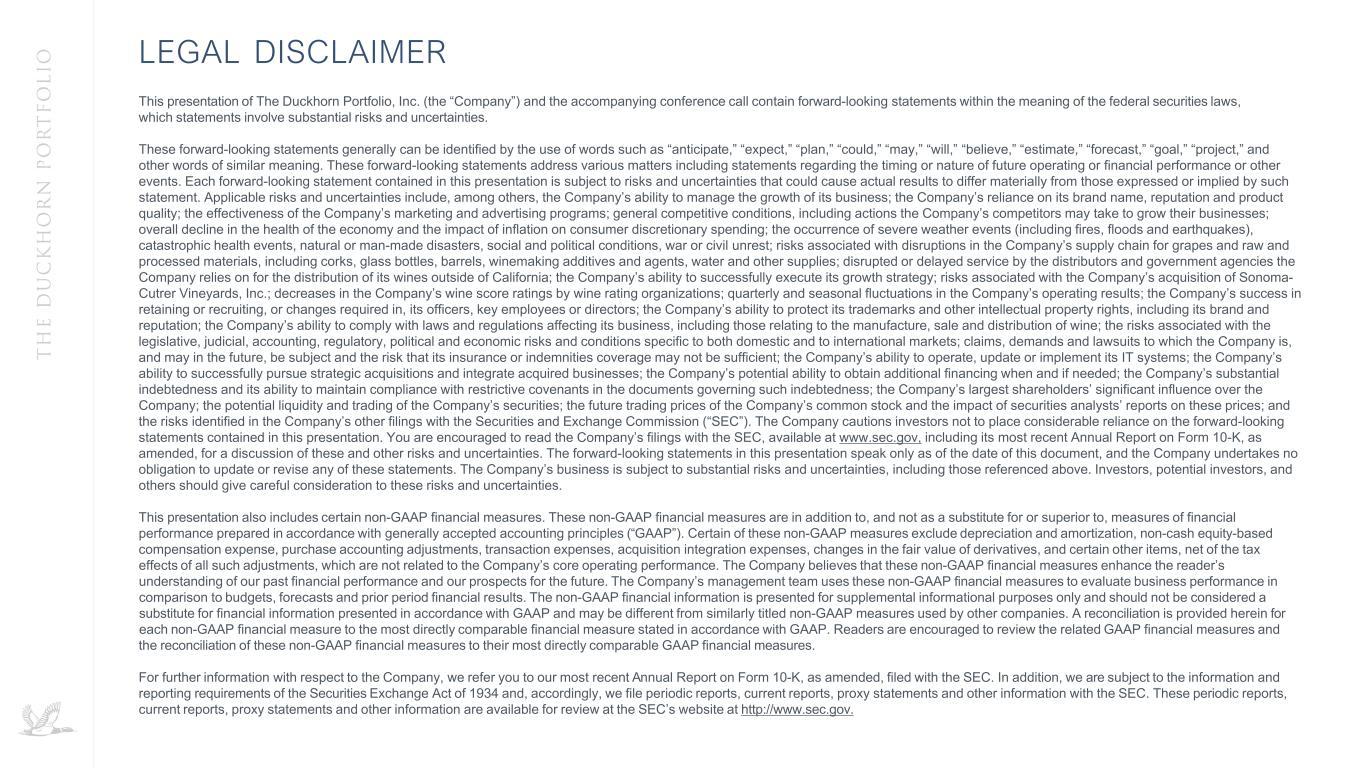
LEGAL DISCLAIMER This presentation of The Duckhorn Portfolio, Inc. (the “Company”) and the accompanying conference call contain forward-looking statements within the meaning of the federal securities laws, which statements involve substantial risks and uncertainties. These forward-looking statements generally can be identified by the use of words such as “anticipate,” “expect,” “plan,” “could,” “may,” “will,” “believe,” “estimate,” “forecast,” “goal,” “project,” and other words of similar meaning. These forward-looking statements address various matters including statements regarding the timing or nature of future operating or financial performance or other events. Each forward-looking statement contained in this presentation is subject to risks and uncertainties that could cause actual results to differ materially from those expressed or implied by such statement. Applicable risks and uncertainties include, among others, the Company’s ability to manage the growth of its business; the Company’s reliance on its brand name, reputation and product quality; the effectiveness of the Company’s marketing and advertising programs; general competitive conditions, including actions the Company’s competitors may take to grow their businesses; overall decline in the health of the economy and the impact of inflation on consumer discretionary spending; the occurrence of severe weather events (including fires, floods and earthquakes), catastrophic health events, natural or man-made disasters, social and political conditions, war or civil unrest; risks associated with disruptions in the Company’s supply chain for grapes and raw and processed materials, including corks, glass bottles, barrels, winemaking additives and agents, water and other supplies; disrupted or delayed service by the distributors and government agencies the Company relies on for the distribution of its wines outside of California; the Company’s ability to successfully execute its growth strategy; risks associated with the Company’s acquisition of Sonoma- Cutrer Vineyards, Inc.; decreases in the Company’s wine score ratings by wine rating organizations; quarterly and seasonal fluctuations in the Company’s operating results; the Company’s success in retaining or recruiting, or changes required in, its officers, key employees or directors; the Company’s ability to protect its trademarks and other intellectual property rights, including its brand and reputation; the Company’s ability to comply with laws and regulations affecting its business, including those relating to the manufacture, sale and distribution of wine; the risks associated with the legislative, judicial, accounting, regulatory, political and economic risks and conditions specific to both domestic and to international markets; claims, demands and lawsuits to which the Company is, and may in the future, be subject and the risk that its insurance or indemnities coverage may not be sufficient; the Company’s ability to operate, update or implement its IT systems; the Company’s ability to successfully pursue strategic acquisitions and integrate acquired businesses; the Company’s potential ability to obtain additional financing when and if needed; the Company’s substantial indebtedness and its ability to maintain compliance with restrictive covenants in the documents governing such indebtedness; the Company’s largest shareholders’ significant influence over the Company; the potential liquidity and trading of the Company’s securities; the future trading prices of the Company’s common stock and the impact of securities analysts’ reports on these prices; and the risks identified in the Company’s other filings with the Securities and Exchange Commission (“SEC”). The Company cautions investors not to place considerable reliance on the forward-looking statements contained in this presentation. You are encouraged to read the Company’s filings with the SEC, available at www.sec.gov, including its most recent Annual Report on Form 10-K, as amended, for a discussion of these and other risks and uncertainties. The forward-looking statements in this presentation speak only as of the date of this document, and the Company undertakes no obligation to update or revise any of these statements. The Company’s business is subject to substantial risks and uncertainties, including those referenced above. Investors, potential investors, and others should give careful consideration to these risks and uncertainties. This presentation also includes certain non-GAAP financial measures. These non-GAAP financial measures are in addition to, and not as a substitute for or superior to, measures of financial performance prepared in accordance with generally accepted accounting principles (“GAAP”). Certain of these non-GAAP measures exclude depreciation and amortization, non-cash equity-based compensation expense, purchase accounting adjustments, transaction expenses, acquisition integration expenses, changes in the fair value of derivatives, and certain other items, net of the tax effects of all such adjustments, which are not related to the Company’s core operating performance. The Company believes that these non-GAAP financial measures enhance the reader’s understanding of our past financial performance and our prospects for the future. The Company’s management team uses these non-GAAP financial measures to evaluate business performance in comparison to budgets, forecasts and prior period financial results. The non-GAAP financial information is presented for supplemental informational purposes only and should not be considered a substitute for financial information presented in accordance with GAAP and may be different from similarly titled non-GAAP measures used by other companies. A reconciliation is provided herein for each non-GAAP financial measure to the most directly comparable financial measure stated in accordance with GAAP. Readers are encouraged to review the related GAAP financial measures and the reconciliation of these non-GAAP financial measures to their most directly comparable GAAP financial measures. For further information with respect to the Company, we refer you to our most recent Annual Report on Form 10-K, as amended, filed with the SEC. In addition, we are subject to the information and reporting requirements of the Securities Exchange Act of 1934 and, accordingly, we file periodic reports, current reports, proxy statements and other information with the SEC. These periodic reports, current reports, proxy statements and other information are available for review at the SEC’s website at http://www.sec.gov.
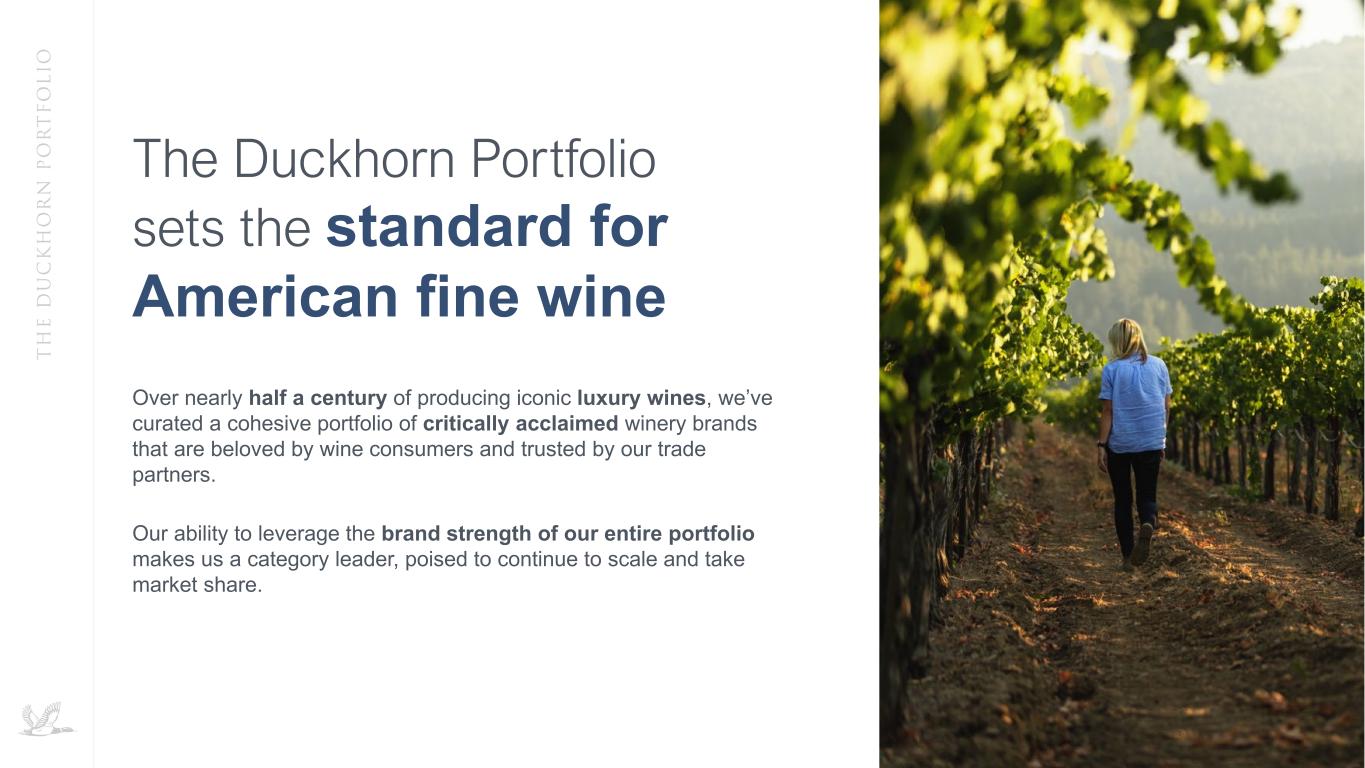
The Duckhorn Portfolio sets the standard for American fine wine Over nearly half a century of producing iconic luxury wines, we’ve curated a cohesive portfolio of critically acclaimed winery brands that are beloved by wine consumers and trusted by our trade partners. Our ability to leverage the brand strength of our entire portfolio makes us a category leader, poised to continue to scale and take market share.
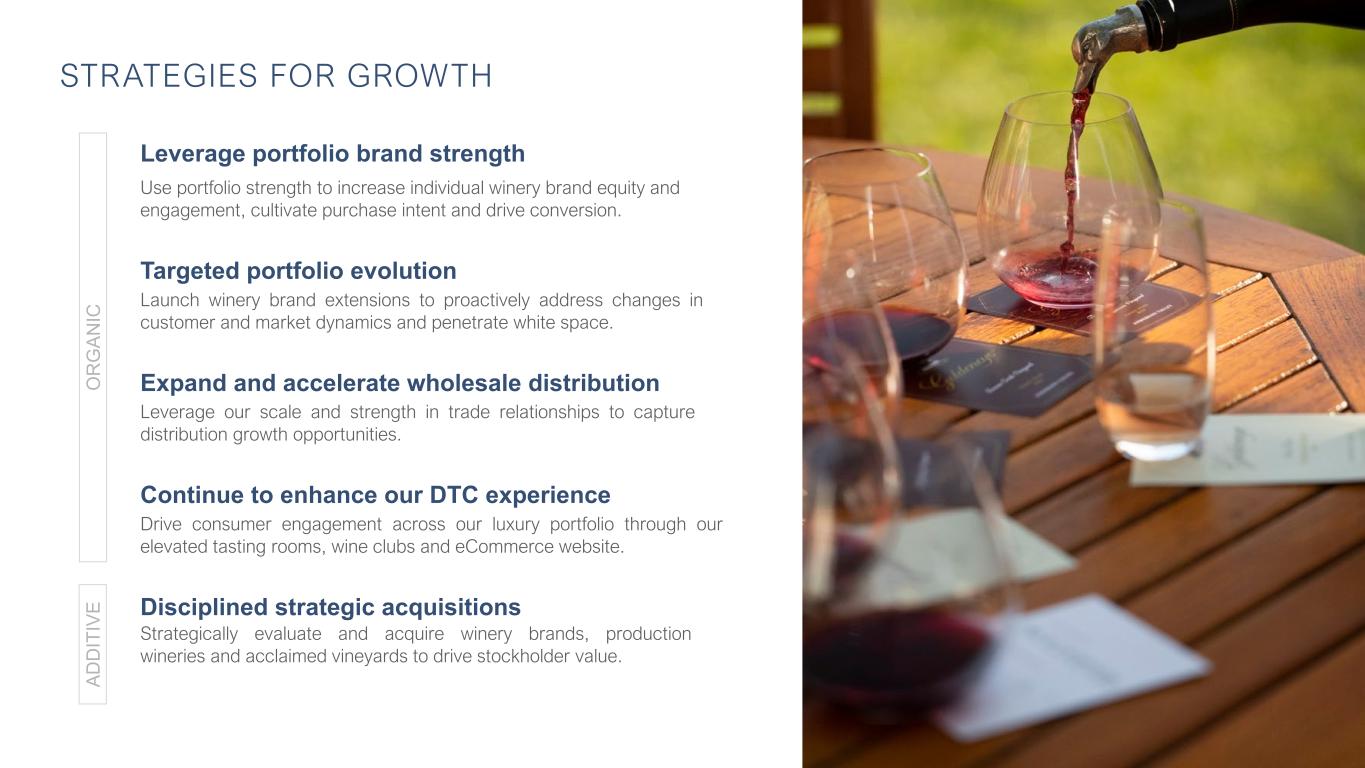
S T R I C T L Y C O N F I D E N T I A L . N O U N A U T H O R I Z E D D I S T R I B U T I O N O R D U P L I C A T I O N . Leverage portfolio brand strength Use portfolio strength to increase individual winery brand equity and engagement, cultivate purchase intent and drive conversion. Targeted portfolio evolution Launch winery brand extensions to proactively address changes in customer and market dynamics and penetrate white space. Expand and accelerate wholesale distribution Leverage our scale and strength in trade relationships to capture distribution growth opportunities. Continue to enhance our DTC experience Drive consumer engagement across our luxury portfolio through our elevated tasting rooms, wine clubs and eCommerce website. Disciplined strategic acquisitions Strategically evaluate and acquire winery brands, production wineries and acclaimed vineyards to drive stockholder value. O R G AN IC AD D IT IV E STRATEGIES FOR GROWTH
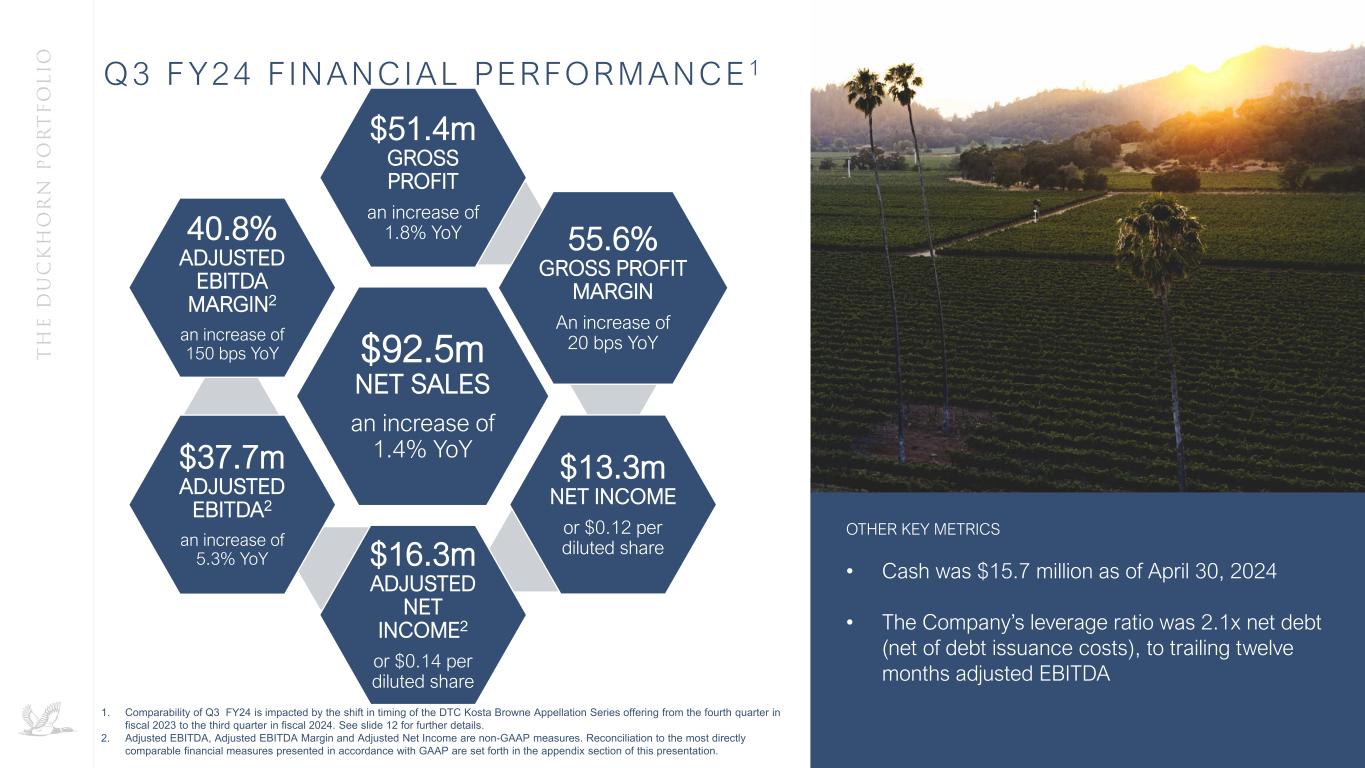
Q3 F Y24 F INANCIAL PERFORMANCE 1 $92.5m NET SALES an increase of 1.4% YoY $51.4m GROSS PROFIT an increase of 1.8% YoY 55.6% GROSS PROFIT MARGIN An increase of 20 bps YoY $13.3m NET INCOME or $0.12 per diluted share$16.3m ADJUSTED NET INCOME2 or $0.14 per diluted share $37.7m ADJUSTED EBITDA2 an increase of 5.3% YoY 40.8% ADJUSTED EBITDA MARGIN2 an increase of 150 bps YoY OTHER KEY METRICS • Cash was $15.7 million as of April 30, 2024 • The Company’s leverage ratio was 2.1x net debt (net of debt issuance costs), to trailing twelve months adjusted EBITDA See Appendix II for other formats 1. Comparability of Q3 FY24 is impacted by the shift in timing of the DTC Kosta Browne Appellation Series offering from the fourth quarter in fiscal 2023 to the third quarter in fiscal 2024. See slide 12 for further details. 2. Adjusted EBITDA, Adjusted EBITDA Margin and Adjusted Net Income are non-GAAP measures. Reconciliation to the most directly comparable financial measures presented in accordance with GAAP are set forth in the appendix section of this presentation.
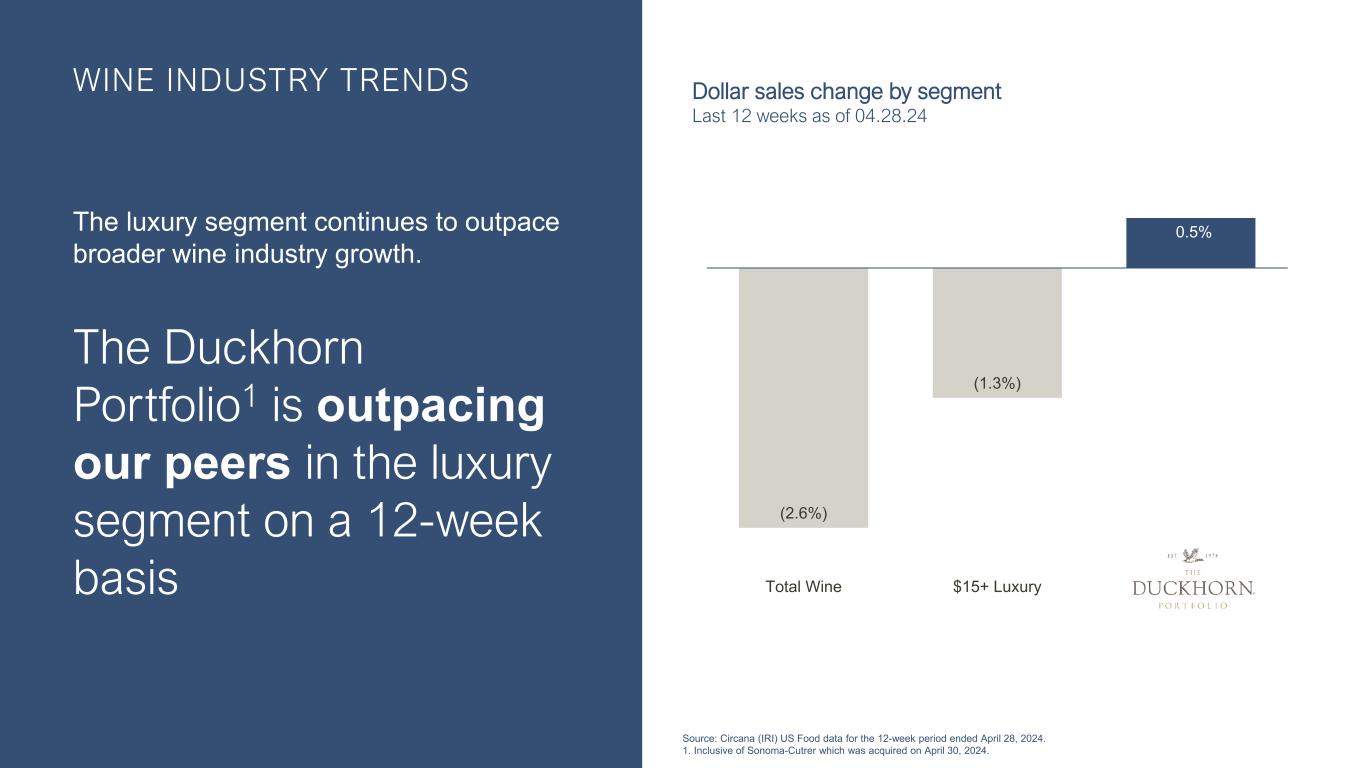
S T R I C T L Y C O N F I D E N T I A L . N O U N A U T H O R I Z E D D I S T R I B U T I O N O R D U P L I C A T I O N . WINE INDUSTRY TRENDS Source: Circana (IRI) US Food data for the 12-week period ended April 28, 2024. 1. Inclusive of Sonoma-Cutrer which was acquired on April 30, 2024. The luxury segment continues to outpace broader wine industry growth. Dollar sales change by segment Last 12 weeks as of 04.28.24 (2.6%) (1.3%) 0.5% Total Wine $15+ Luxury The Duckhorn Portfolio The Duckhorn Portfolio1 is outpacing our peers in the luxury segment on a 12-week basis
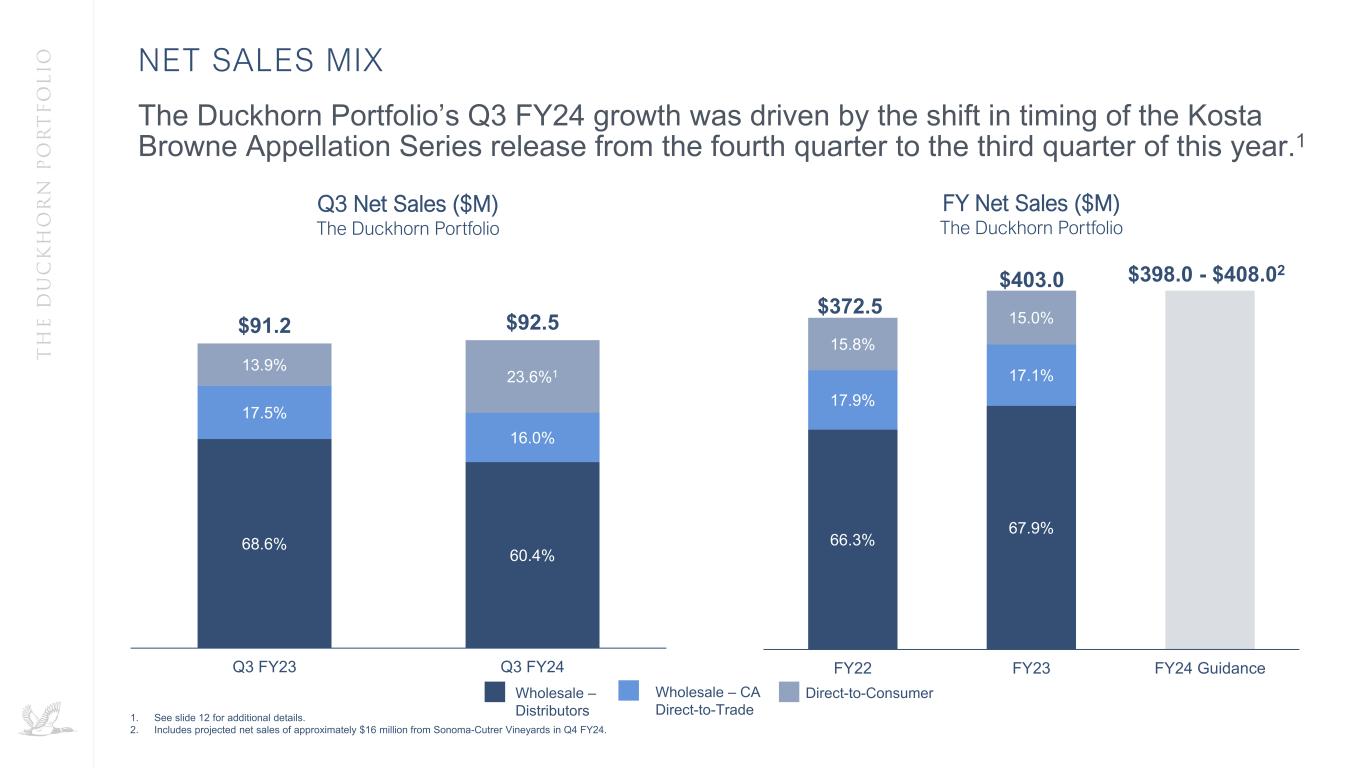
68.6% 60.4% 17.5% 16.0% 13.9% 23.6%1 $91.2 $92.5 Q3 FY23 Q3 FY24 Q3 Net Sales ($M) The Duckhorn Portfolio 66.3% 67.9% 17.9% 17.1% 15.8% 15.0%$372.5 $403.0 FY22 FY23 FY24 Guidance FY Net Sales ($M) The Duckhorn Portfolio Wholesale – Distributors Wholesale – CA Direct-to-Trade Direct-to-Consumer NET SALES MIX The Duckhorn Portfolio’s Q3 FY24 growth was driven by the shift in timing of the Kosta Browne Appellation Series release from the fourth quarter to the third quarter of this year.1 $398.0 - $408.02 1. See slide 12 for additional details. 2. Includes projected net sales of approximately $16 million from Sonoma-Cutrer Vineyards in Q4 FY24.
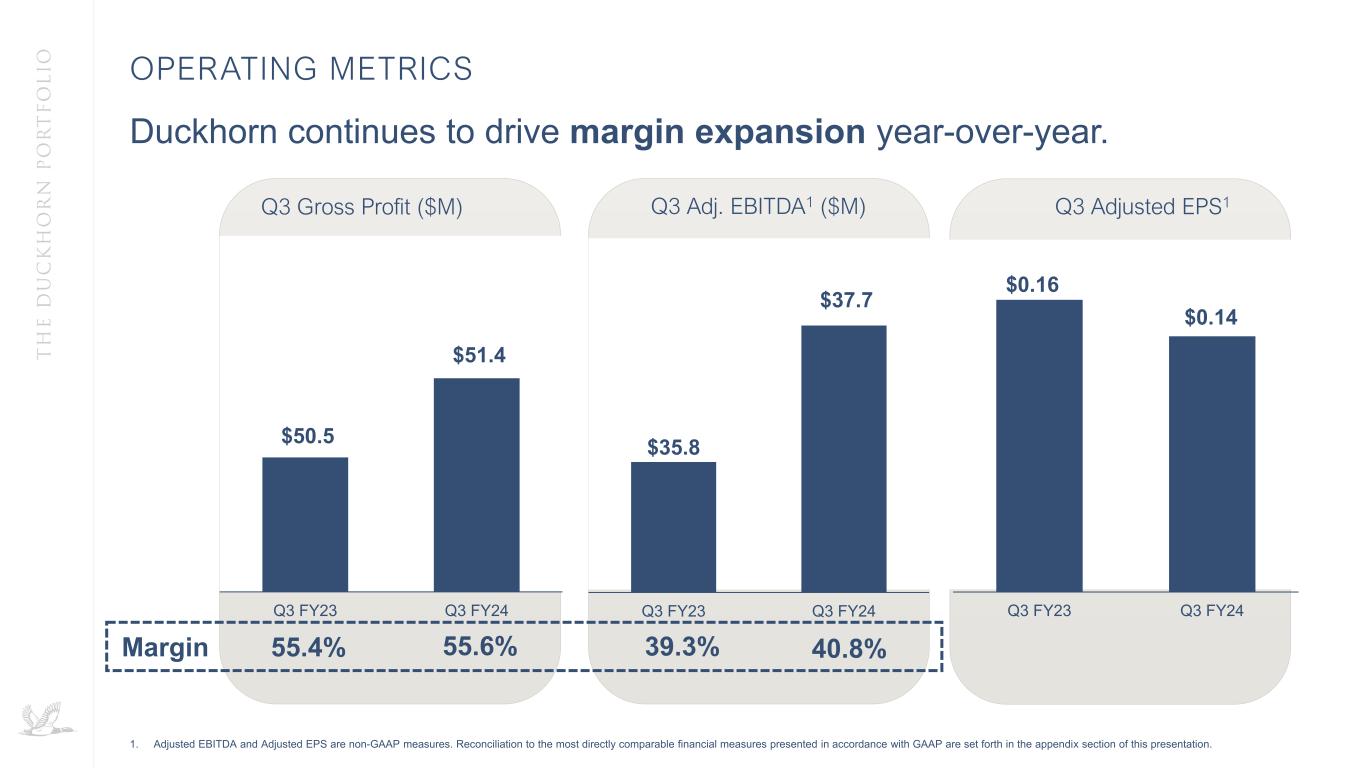
Duckhorn continues to drive margin expansion year-over-year. $50.5 $51.4 Q3 FY23 Q3 FY24 Q3 Gross Profit ($M) OPERATING METRICS 55.4% $35.8 $37.7 Q3 FY23 Q3 FY24 Q3 Adj. EBITDA1 ($M) $0.16 $0.14 Q3 FY23 Q3 FY24 Q3 Adjusted EPS1 55.6% 40.8%39.3% 1. Adjusted EBITDA and Adjusted EPS are non-GAAP measures. Reconciliation to the most directly comparable financial measures presented in accordance with GAAP are set forth in the appendix section of this presentation. Margin
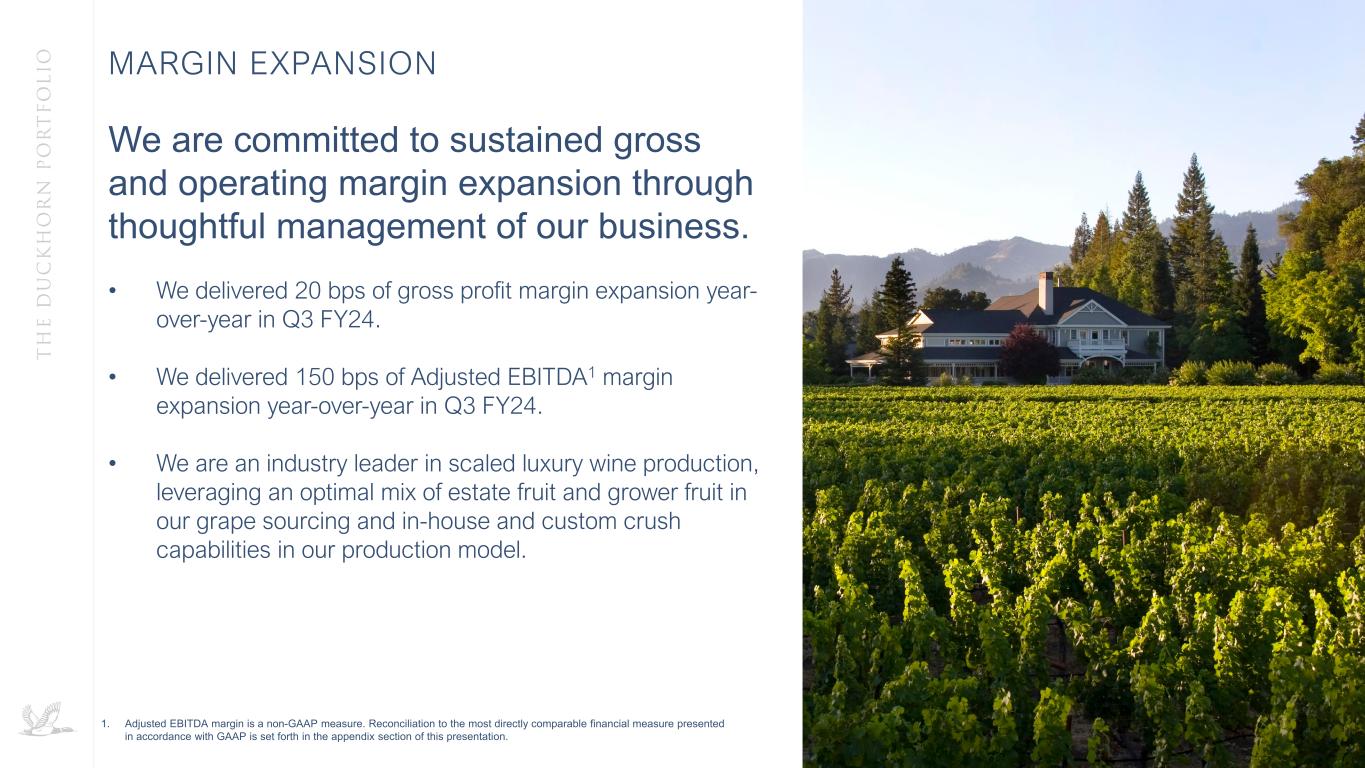
MARGIN EXPANSION 1. Adjusted EBITDA margin is a non-GAAP measure. Reconciliation to the most directly comparable financial measure presented in accordance with GAAP is set forth in the appendix section of this presentation. We are committed to sustained gross and operating margin expansion through thoughtful management of our business. • We delivered 20 bps of gross profit margin expansion year- over-year in Q3 FY24. • We delivered 150 bps of Adjusted EBITDA1 margin expansion year-over-year in Q3 FY24. • We are an industry leader in scaled luxury wine production, leveraging an optimal mix of estate fruit and grower fruit in our grape sourcing and in-house and custom crush capabilities in our production model.
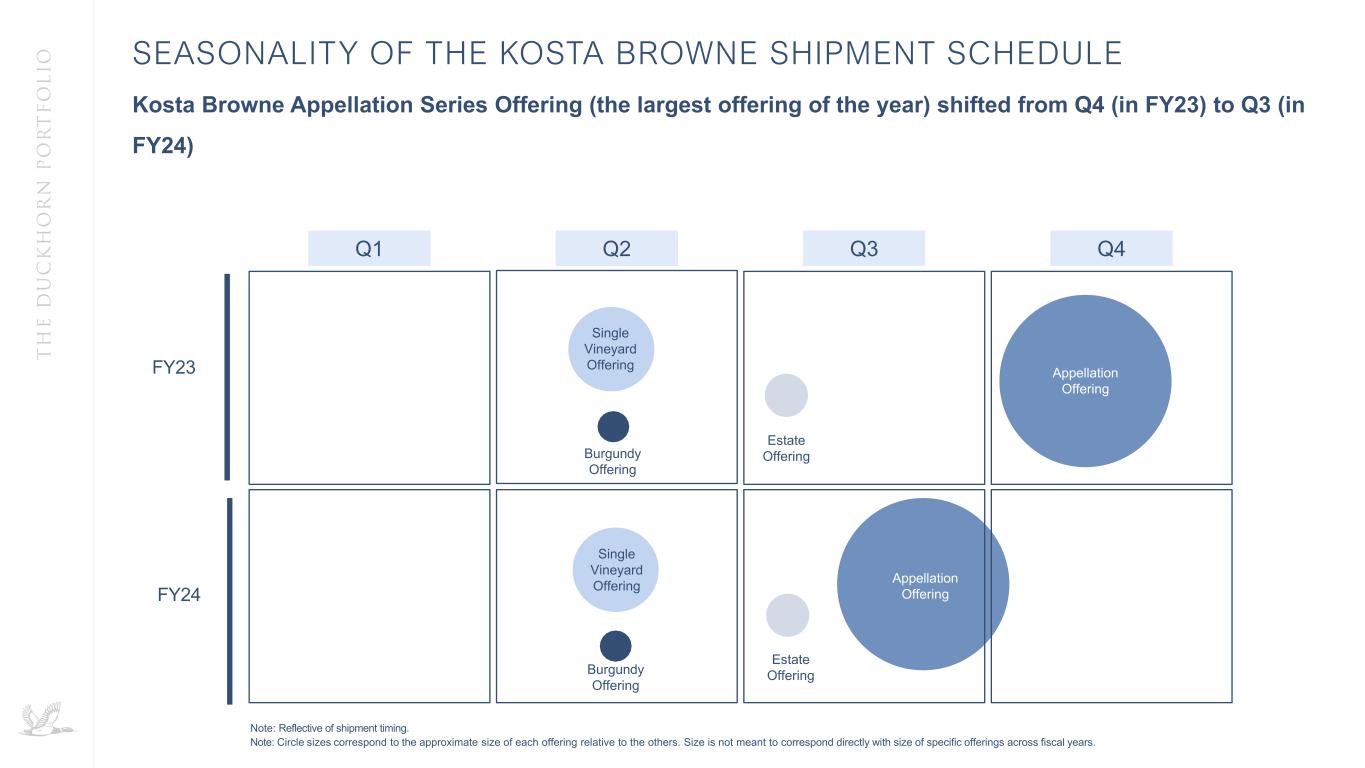
FY23 FY24 Note: Reflective of shipment timing. Note: Circle sizes correspond to the approximate size of each offering relative to the others. Size is not meant to correspond directly with size of specific offerings across fiscal years. Kosta Browne Appellation Series Offering (the largest offering of the year) shifted from Q4 (in FY23) to Q3 (in FY24) Q1 Single Vineyard Offering Single Vineyard Offering Burgundy Offering Burgundy Offering Estate Offering Estate Offering Appellation Offering Appellation Offering SEASONALITY OF THE KOSTA BROWNE SHIPMENT SCHEDULE Q2 Q3 Q4
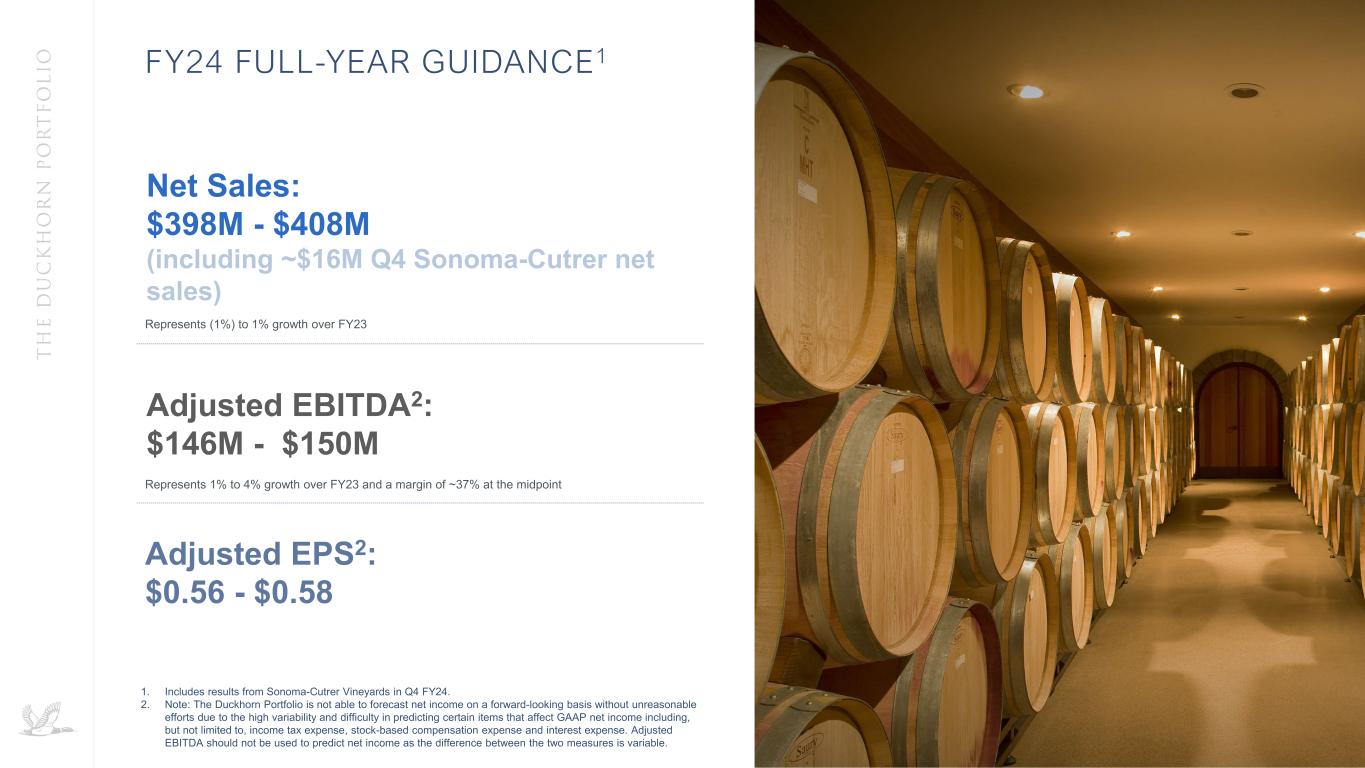
Net Sales: $398M - $408M (including ~$16M Q4 Sonoma-Cutrer net sales) Adjusted EBITDA2: $146M - $150M Represents (1%) to 1% growth over FY23 Represents 1% to 4% growth over FY23 and a margin of ~37% at the midpoint FY24 FULL-YEAR GUIDANCE1 1. Includes results from Sonoma-Cutrer Vineyards in Q4 FY24. 2. Note: The Duckhorn Portfolio is not able to forecast net income on a forward-looking basis without unreasonable efforts due to the high variability and difficulty in predicting certain items that affect GAAP net income including, but not limited to, income tax expense, stock-based compensation expense and interest expense. Adjusted EBITDA should not be used to predict net income as the difference between the two measures is variable. Adjusted EPS2: $0.56 - $0.58
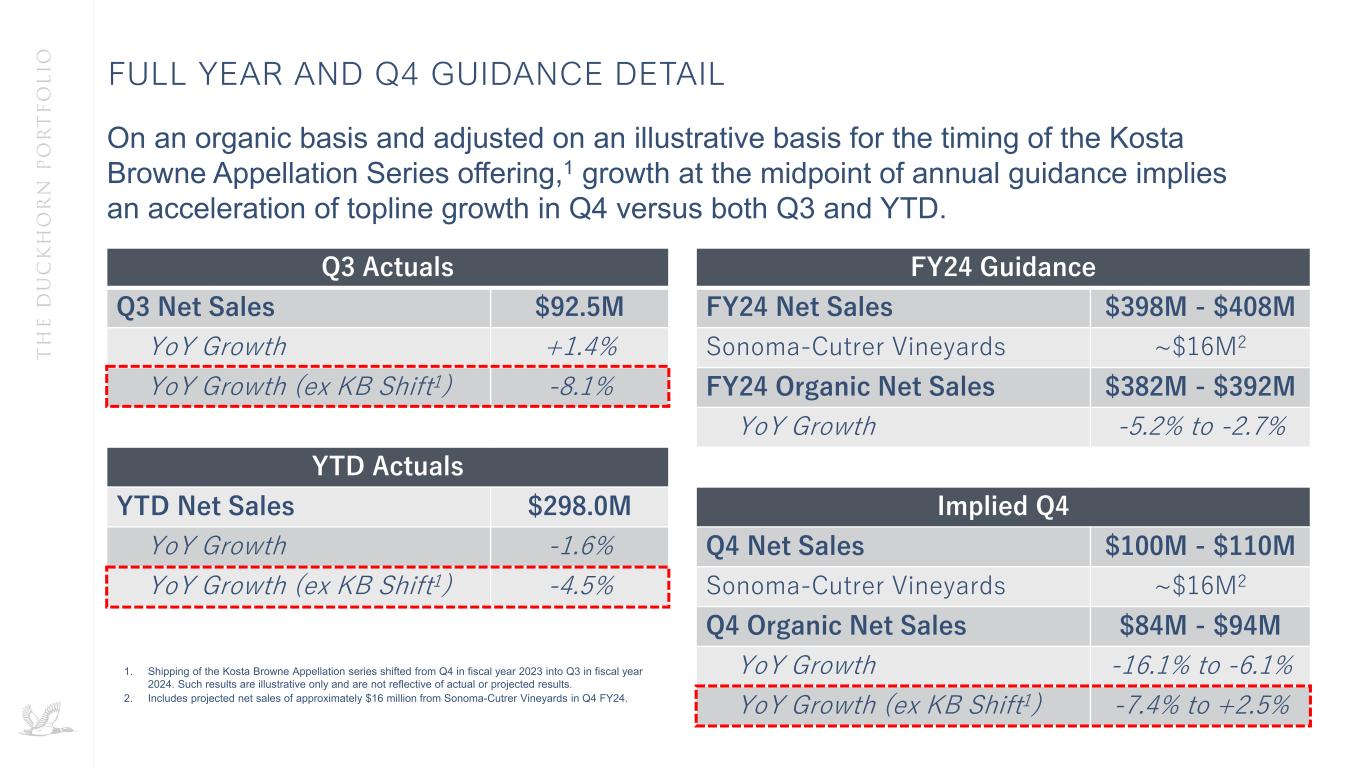
FULL YEAR AND Q4 GUIDANCE DETAIL On an organic basis and adjusted on an illustrative basis for the timing of the Kosta Browne Appellation Series offering,1 growth at the midpoint of annual guidance implies an acceleration of topline growth in Q4 versus both Q3 and YTD. Q3 Actuals Q3 Net Sales $92.5M YoY Growth +1.4% YoY Growth (ex KB Shift1) -8.1% YTD Actuals YTD Net Sales $298.0M YoY Growth -1.6% YoY Growth (ex KB Shift1) -4.5% FY24 Guidance FY24 Net Sales $398M - $408M Sonoma-Cutrer Vineyards ~$16M2 FY24 Organic Net Sales $382M - $392M YoY Growth -5.2% to -2.7% Implied Q4 Q4 Net Sales $100M - $110M Sonoma-Cutrer Vineyards ~$16M2 Q4 Organic Net Sales $84M - $94M YoY Growth -16.1% to -6.1% YoY Growth (ex KB Shift1) -7.4% to +2.5% 1. Shipping of the Kosta Browne Appellation series shifted from Q4 in fiscal year 2023 into Q3 in fiscal year 2024. Such results are illustrative only and are not reflective of actual or projected results. 2. Includes projected net sales of approximately $16 million from Sonoma-Cutrer Vineyards in Q4 FY24.
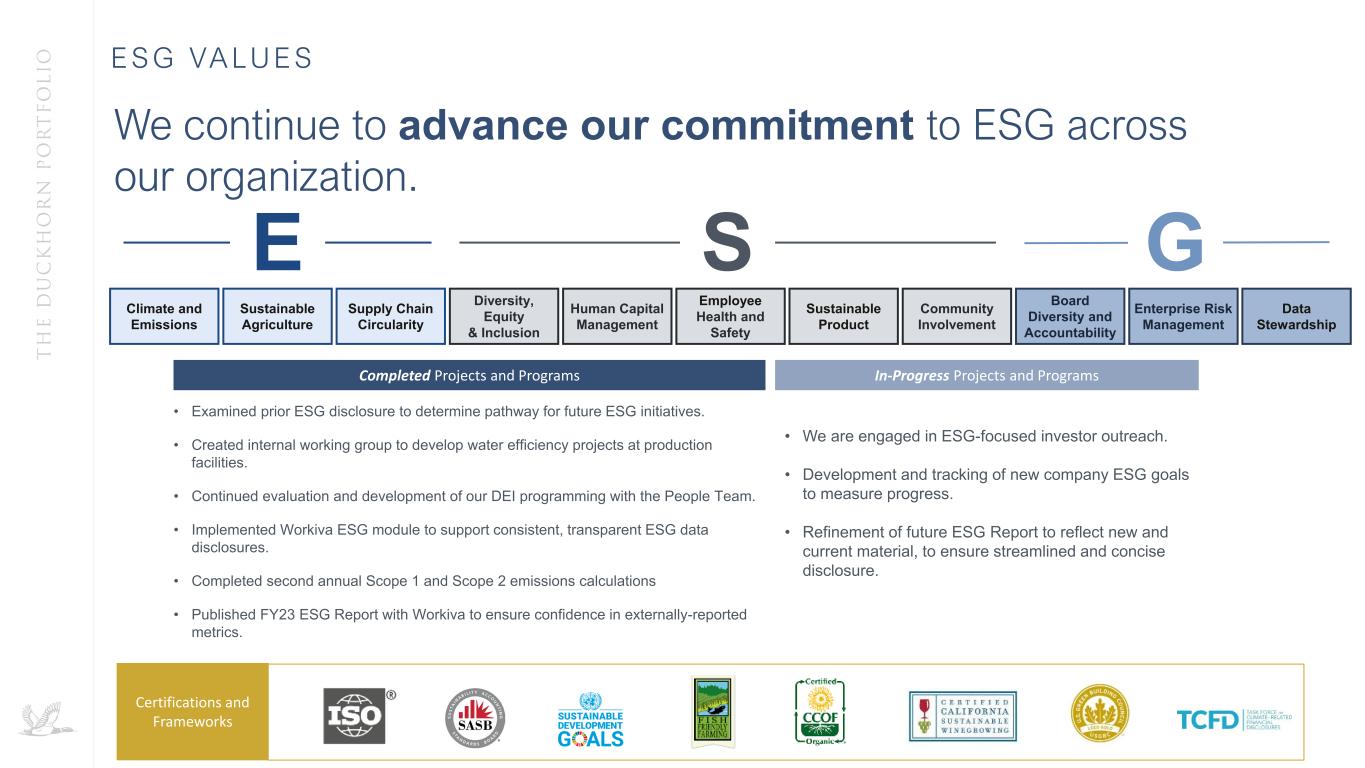
E S G E S G VA LU E S Enterprise Risk Management Board Diversity and Accountability Diversity, Equity & Inclusion Human Capital Management Community Involvement Sustainable Product Employee Health and Safety Climate and Emissions Sustainable Agriculture Supply Chain Circularity Data Stewardship • Examined prior ESG disclosure to determine pathway for future ESG initiatives. • Created internal working group to develop water efficiency projects at production facilities. • Continued evaluation and development of our DEI programming with the People Team. • Implemented Workiva ESG module to support consistent, transparent ESG data disclosures. • Completed second annual Scope 1 and Scope 2 emissions calculations • Published FY23 ESG Report with Workiva to ensure confidence in externally-reported metrics. Completed Projects and Programs Certifications and Frameworks In-Progress Projects and Programs • We are engaged in ESG-focused investor outreach. • Development and tracking of new company ESG goals to measure progress. • Refinement of future ESG Report to reflect new and current material, to ensure streamlined and concise disclosure. We continue to advance our commitment to ESG across our organization.
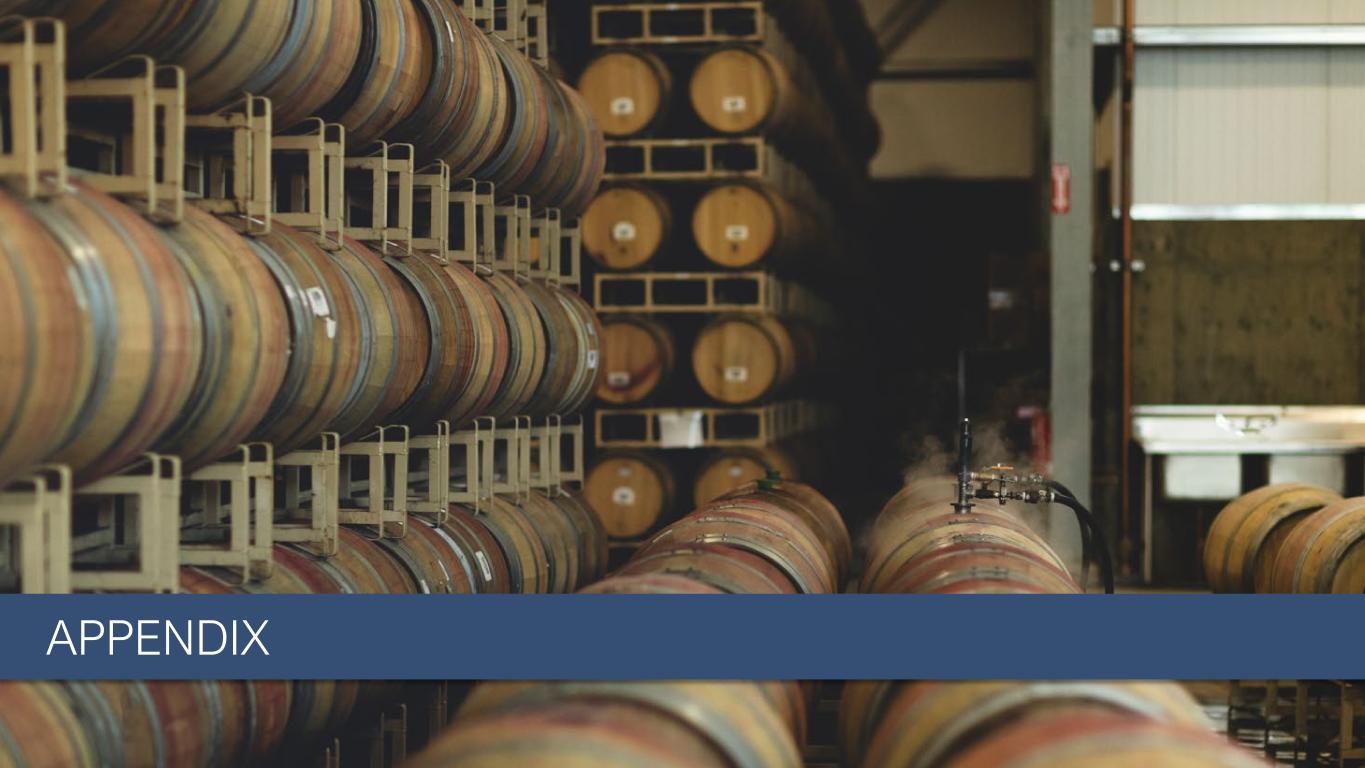
S T R I C T L Y C O N F I D E N T I A L . N O U N A U T H O R I Z E D D I S T R I B U T I O N O R D U P L I C A T I O N . APPENDIX
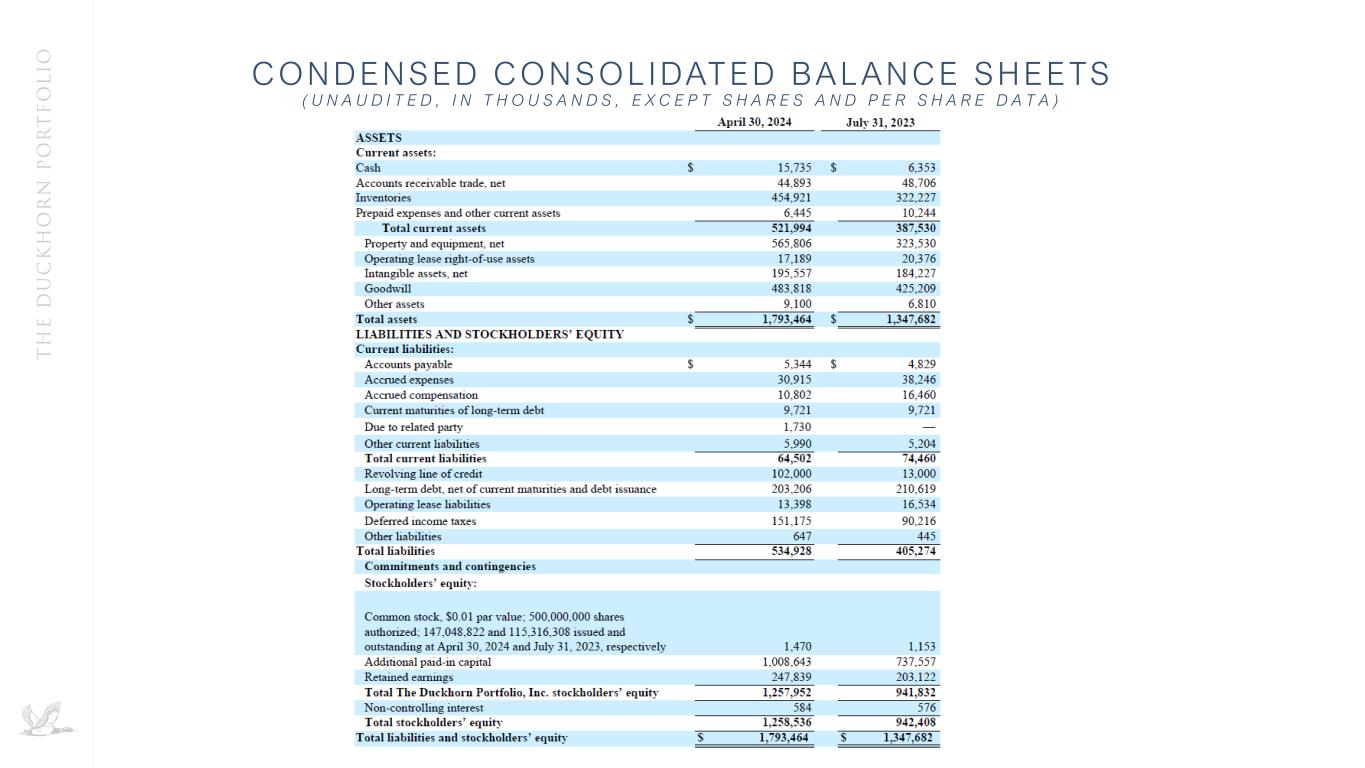
CONDENSED CONSOLIDATED BALANCE SHEETS ( U N A U D I T E D , I N T H O U S A N D S , E X C E P T S H A R E S A N D P E R S H A R E D A T A )
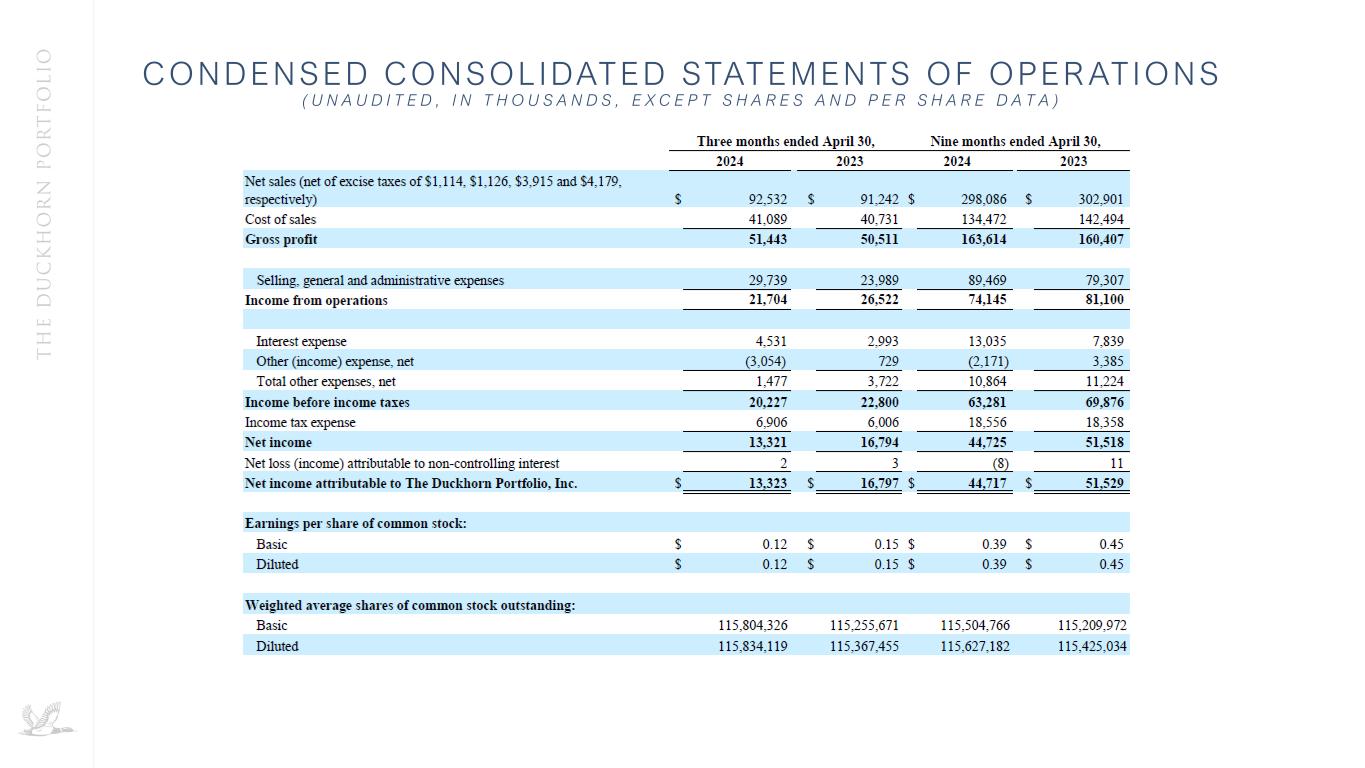
CONDENSED CONSOLIDATED STATEMENTS OF OPER ATIONS ( U N A U D I T E D , I N T H O U S A N D S , E X C E P T S H A R E S A N D P E R S H A R E D A T A )
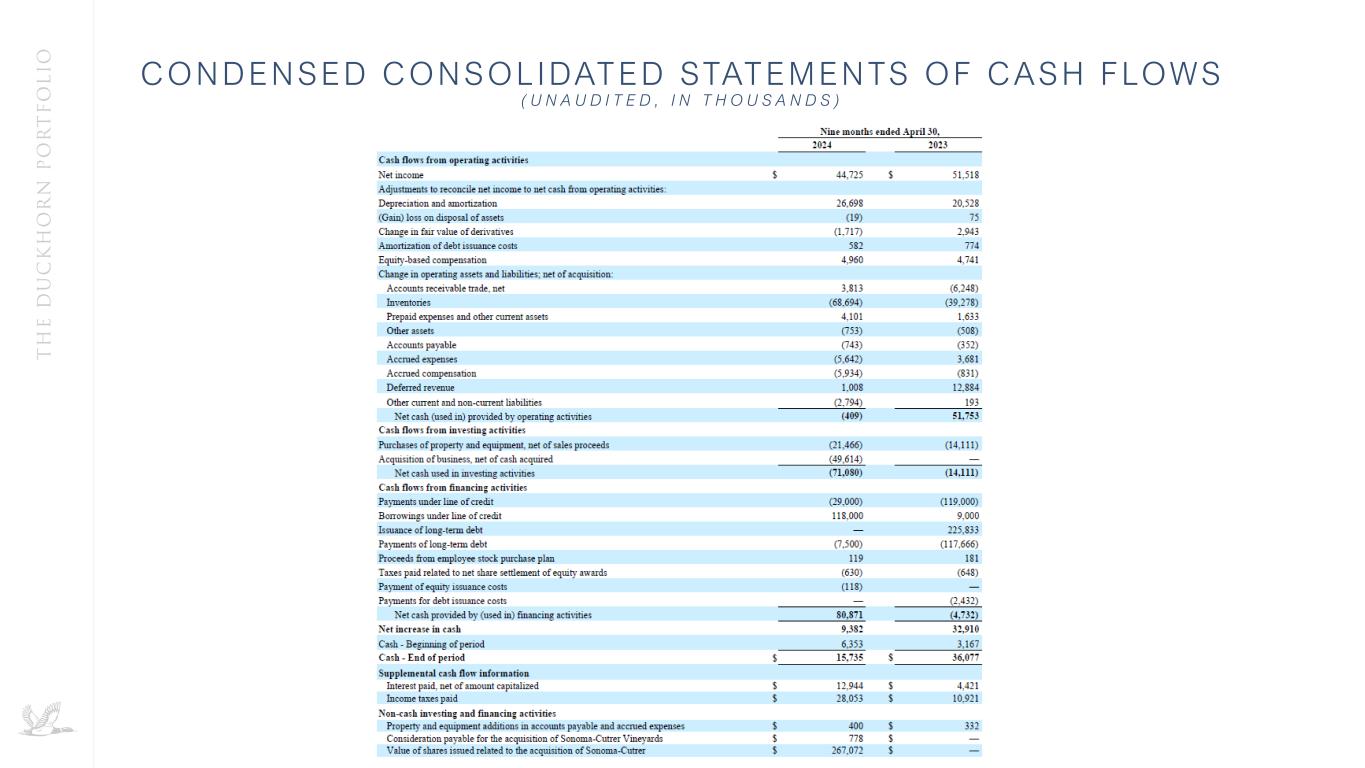
CONDENSED CONSOLIDATED STATEMENTS OF CASH FLOWS ( U N A U D I T E D , I N T H O U S A N D S )
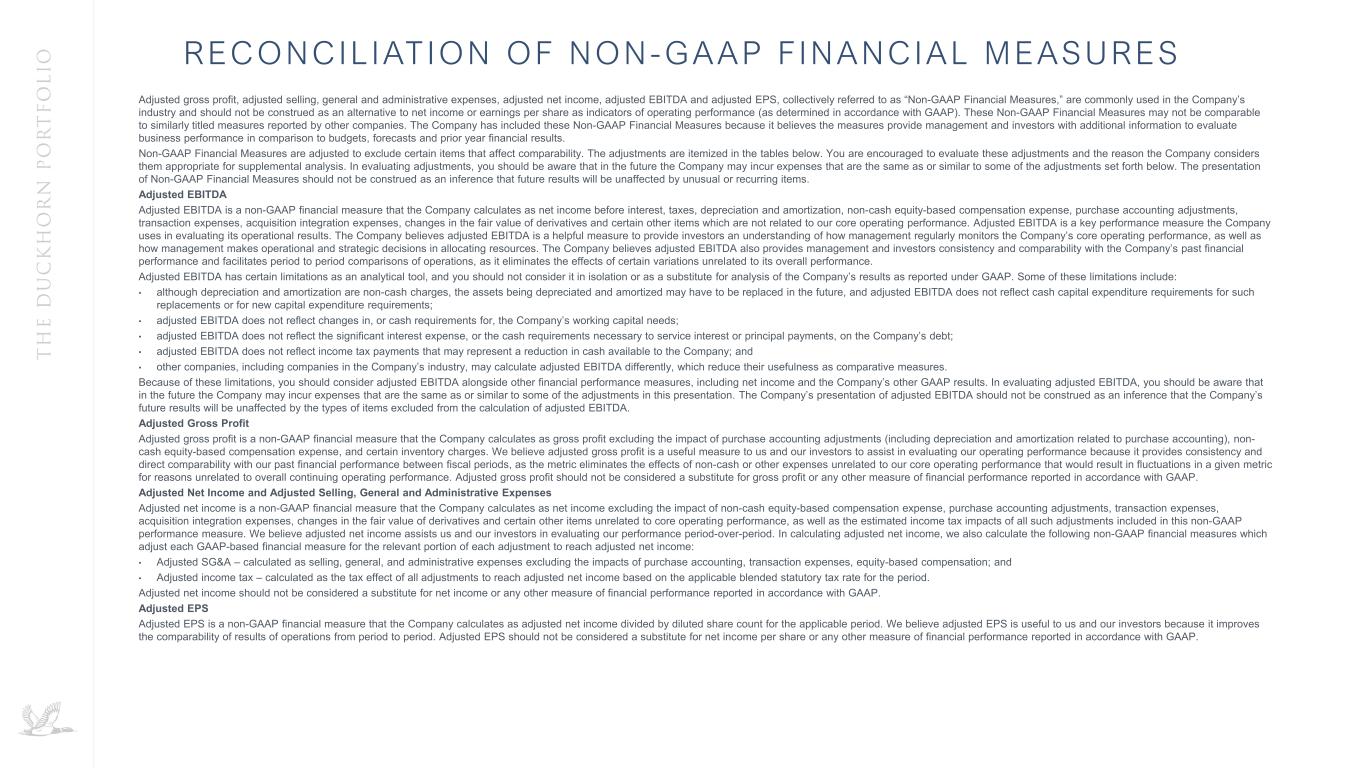
Adjusted gross profit, adjusted selling, general and administrative expenses, adjusted net income, adjusted EBITDA and adjusted EPS, collectively referred to as “Non-GAAP Financial Measures,” are commonly used in the Company’s industry and should not be construed as an alternative to net income or earnings per share as indicators of operating performance (as determined in accordance with GAAP). These Non-GAAP Financial Measures may not be comparable to similarly titled measures reported by other companies. The Company has included these Non-GAAP Financial Measures because it believes the measures provide management and investors with additional information to evaluate business performance in comparison to budgets, forecasts and prior year financial results. Non-GAAP Financial Measures are adjusted to exclude certain items that affect comparability. The adjustments are itemized in the tables below. You are encouraged to evaluate these adjustments and the reason the Company considers them appropriate for supplemental analysis. In evaluating adjustments, you should be aware that in the future the Company may incur expenses that are the same as or similar to some of the adjustments set forth below. The presentation of Non-GAAP Financial Measures should not be construed as an inference that future results will be unaffected by unusual or recurring items. Adjusted EBITDA Adjusted EBITDA is a non-GAAP financial measure that the Company calculates as net income before interest, taxes, depreciation and amortization, non-cash equity-based compensation expense, purchase accounting adjustments, transaction expenses, acquisition integration expenses, changes in the fair value of derivatives and certain other items which are not related to our core operating performance. Adjusted EBITDA is a key performance measure the Company uses in evaluating its operational results. The Company believes adjusted EBITDA is a helpful measure to provide investors an understanding of how management regularly monitors the Company’s core operating performance, as well as how management makes operational and strategic decisions in allocating resources. The Company believes adjusted EBITDA also provides management and investors consistency and comparability with the Company’s past financial performance and facilitates period to period comparisons of operations, as it eliminates the effects of certain variations unrelated to its overall performance. Adjusted EBITDA has certain limitations as an analytical tool, and you should not consider it in isolation or as a substitute for analysis of the Company’s results as reported under GAAP. Some of these limitations include: • although depreciation and amortization are non-cash charges, the assets being depreciated and amortized may have to be replaced in the future, and adjusted EBITDA does not reflect cash capital expenditure requirements for such replacements or for new capital expenditure requirements; • adjusted EBITDA does not reflect changes in, or cash requirements for, the Company’s working capital needs; • adjusted EBITDA does not reflect the significant interest expense, or the cash requirements necessary to service interest or principal payments, on the Company’s debt; • adjusted EBITDA does not reflect income tax payments that may represent a reduction in cash available to the Company; and • other companies, including companies in the Company’s industry, may calculate adjusted EBITDA differently, which reduce their usefulness as comparative measures. Because of these limitations, you should consider adjusted EBITDA alongside other financial performance measures, including net income and the Company’s other GAAP results. In evaluating adjusted EBITDA, you should be aware that in the future the Company may incur expenses that are the same as or similar to some of the adjustments in this presentation. The Company’s presentation of adjusted EBITDA should not be construed as an inference that the Company’s future results will be unaffected by the types of items excluded from the calculation of adjusted EBITDA. Adjusted Gross Profit Adjusted gross profit is a non-GAAP financial measure that the Company calculates as gross profit excluding the impact of purchase accounting adjustments (including depreciation and amortization related to purchase accounting), non- cash equity-based compensation expense, and certain inventory charges. We believe adjusted gross profit is a useful measure to us and our investors to assist in evaluating our operating performance because it provides consistency and direct comparability with our past financial performance between fiscal periods, as the metric eliminates the effects of non-cash or other expenses unrelated to our core operating performance that would result in fluctuations in a given metric for reasons unrelated to overall continuing operating performance. Adjusted gross profit should not be considered a substitute for gross profit or any other measure of financial performance reported in accordance with GAAP. Adjusted Net Income and Adjusted Selling, General and Administrative Expenses Adjusted net income is a non-GAAP financial measure that the Company calculates as net income excluding the impact of non-cash equity-based compensation expense, purchase accounting adjustments, transaction expenses, acquisition integration expenses, changes in the fair value of derivatives and certain other items unrelated to core operating performance, as well as the estimated income tax impacts of all such adjustments included in this non-GAAP performance measure. We believe adjusted net income assists us and our investors in evaluating our performance period-over-period. In calculating adjusted net income, we also calculate the following non-GAAP financial measures which adjust each GAAP-based financial measure for the relevant portion of each adjustment to reach adjusted net income: • Adjusted SG&A – calculated as selling, general, and administrative expenses excluding the impacts of purchase accounting, transaction expenses, equity-based compensation; and • Adjusted income tax – calculated as the tax effect of all adjustments to reach adjusted net income based on the applicable blended statutory tax rate for the period. Adjusted net income should not be considered a substitute for net income or any other measure of financial performance reported in accordance with GAAP. Adjusted EPS Adjusted EPS is a non-GAAP financial measure that the Company calculates as adjusted net income divided by diluted share count for the applicable period. We believe adjusted EPS is useful to us and our investors because it improves the comparability of results of operations from period to period. Adjusted EPS should not be considered a substitute for net income per share or any other measure of financial performance reported in accordance with GAAP. RECONCIL IAT ION OF NON-GAAP F INANCIAL MEASURES
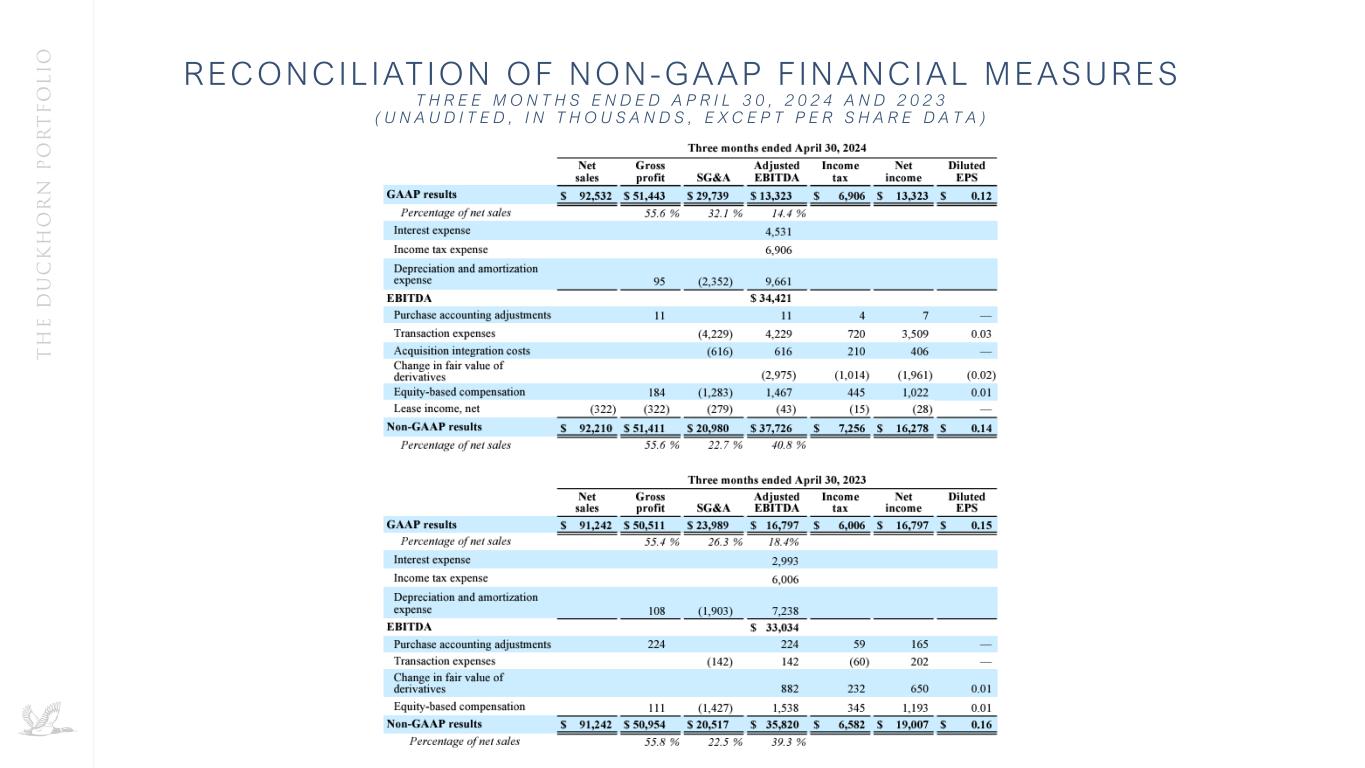
RECONCIL IAT ION OF NON-GAAP F INANCIAL MEASURES T H R E E M O N T H S E N D E D A P R I L 3 0 , 2 0 2 4 A N D 2 0 2 3 ( U N A U D I T E D , I N T H O U S A N D S , E X C E P T P E R S H A R E D A T A )

S T R I C T L Y C O N F I D E N T I A L . N O U N A U T H O R I Z E D D I S T R I B U T I O N O R D U P L I C A T I O N .



















